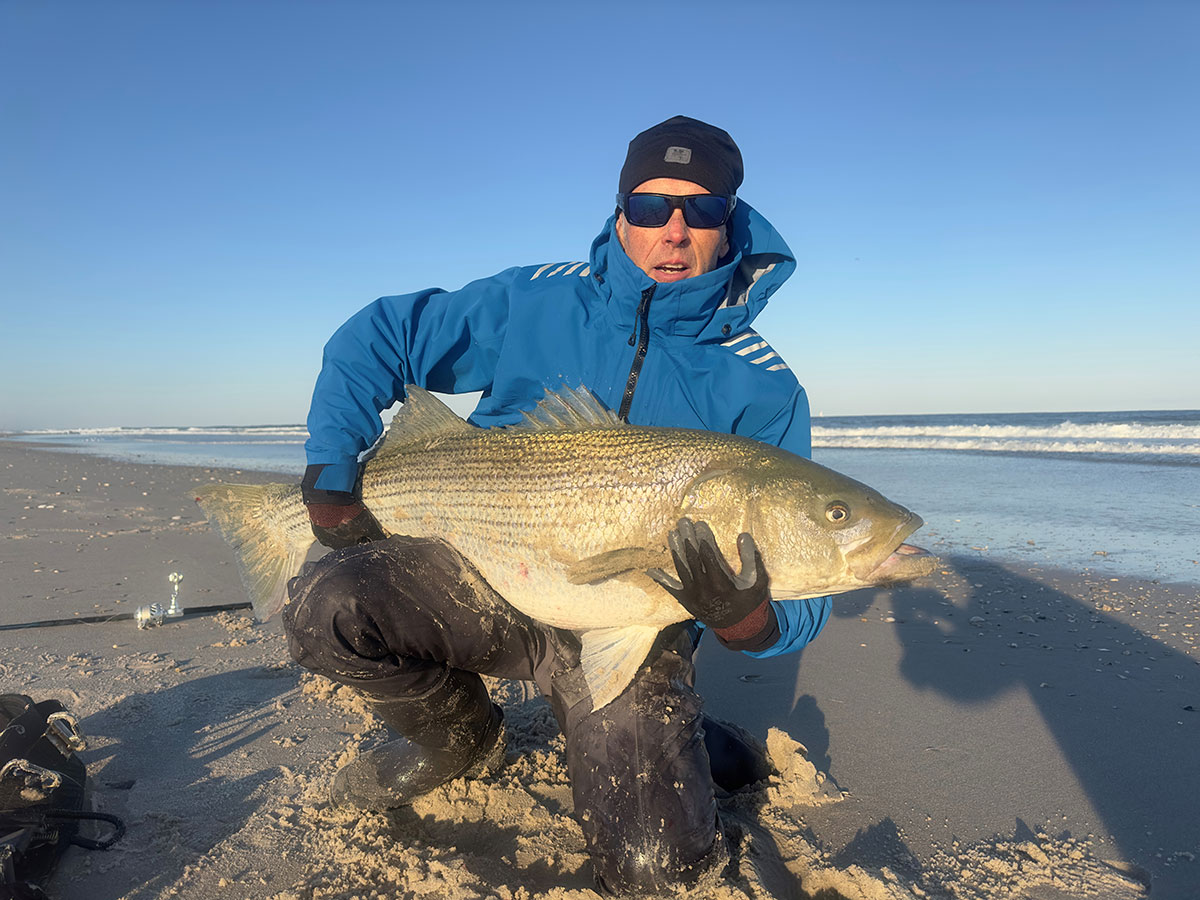
A look at fluke, sea bass, porgies and stripers in the New Year.
We’re heading into another winter show season, with Wildwood (Jan. 6-7), the World Fishing and Outdoor Expo (Jan. 12-14) and NY Boat Show (Jan. 24-28) leading the way in terms of multi-day events. On top of those big regional events, you’ll also find The Fisherman’s staff at a number of single day events as well, including this month’s Delaware Valley Surf Anglers (Jan. 20) out in Warminster, PA.
There will be a lot of chatter at these shows about the 2024 regulations, and the deeper we get into the show season the more conversations we’ll all be having about seasons, sizes and bag limits in the New Year. While it’s still too soon in the management process to tell what those exact regulations might look like, we do have a general idea about the overall quotas and management proposals. The good news is that a lot of this stuff could be worse. The bad news? Well, suffice to say it’s not good.
What About Fluke?
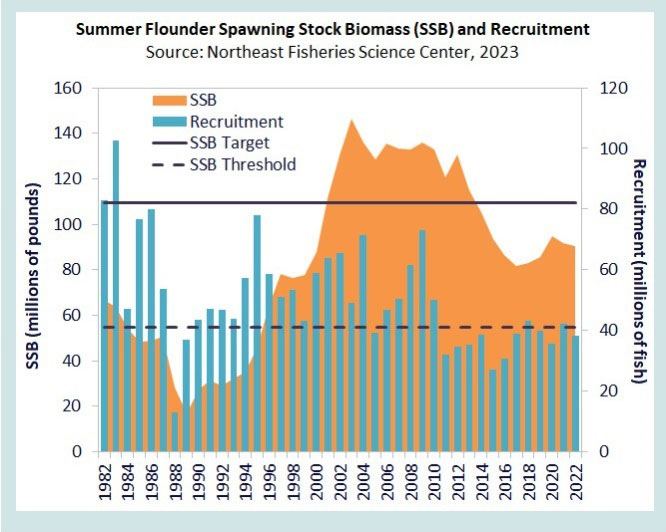
According to statistics compiled by the American Sportfishing Association (ASA) the most targeted saltwater species in the United States is redfish (20.6%); interestingly enough, the species that comes in at number two and ahead of grouper, sea bass, spotted trout, weakfish, and yes even striped bass is flounder or fluke (15.2%). These national numbers correlate pretty well with The Fisherman’s own annual reader survey which shows summer flounder consistently ranking #1 with our readers (99% importance rate). Personally I see fluke as the straw that stirs the drink in our region; regrettably, we won’t be getting as many sips from the cup in 2024.
Bottom line, we’re getting a 28% reduction in recreational fluke quota this season. At first, the ‘powers that be’ had a 40% cutback in allowable biological catch (ABC) on the table, but thanks in part to a new harvest control rule mechanism shepherded through the process by angling advocates including the ASA, the reduction won’t be as bad. The main problem is that we’re given a recreational harvest limit (RHL) each year that comes in well below the stated annual harvest numbers derived from the Marine Recreational Information Program (MRIP). Essentially the new harvest control rule allows for a little more stability from year-to-year fishery, which gets us down to a lower 28% reduction.
According to Capt. Harvey Yenkinson who sits on the Summer Flounder, Scup, and Black Sea Bass advisory panel for the Mid Atlantic Fishery Management Council (MAFMC) which effectively manages fisheries in federal waters beyond the 3-mile-line, the council process involves a complex system that attempts to estimate our catch for 2024 and 2025 based on the 2023 MRIP data. Based on the MRIP data on harvest and dead discards from released fluke, MAFMC has determined that we have to change regulations in order to reduce our catch.
“I fought this at the meeting arguing the monitoring committee was disregarding the socioeconomic impact this will have,” Capt. Yenkinson said, noting that socioeconomic data is a requirement under the federal Magnuson Stevens Fishery Management and Conservation Act. “I also argued that the committee is not considering a new pilot study that showed MRIP data may be overestimating our catch by up to 40%,” he added.
NOAA’S “Bombshell”
In our September, 2023 monthly edition, I wrote an article called NOAA Bombshell! Angler Effort Surveys Still Flawed which you can find at TheFisherman.com that detailed an August 7th conference call with recreational fishing stakeholders during which NOAA Fisheries admitted that their new Fishing Effort Survey used in MRIP estimates is likely overestimating angler effort by as much as 30 to 40%.
“The estimates are lower on effort than what the current design indicates, which is a major difference when you’re using those effort estimates to produce catch estimates that go into assessments and are part of the process for us in establishing quotas both recreationally and commercially,” said Maryland’s Mike Luisi just 24 hours after the NOAA Fisheries bombshell was dropped. During a joint meeting of the Atlantic States Marine Fisheries Commission (ASMFC) and MAFMC where 2024 specifications were to be set for summer flounder, black sea bass and porgy, Luisi referenced the discrepancy between a new pilot study of angler effort being coordinated by the federal fisheries agency and the existing MRIP data.
“The follow-up study will be conducted over the course of 2024 and from what I remember from yesterday’s discussion, it is thought that by 2026 the new information that comes from the study, if there is new information, will be factored in to management by 2026,” Luisi added. It shouldn’t be lost on anyone – not the general public or the fisheries managers themselves – that a 30 to 40% overestimate in MRIP and a 28% cutback in fluke for 2024 seems counterintuitive.
The devil as they say is in the details, and we won’t really know more about what our ’24 fluke season, size and bag limits look like until the state management councils and advisory panels convene sometime in February or March, but I’m guessing New Jersey’s slot limit for fluke goes away, we start with a size limit of at least 18 inches and lose some days of season.
Porgy & Sea Bass
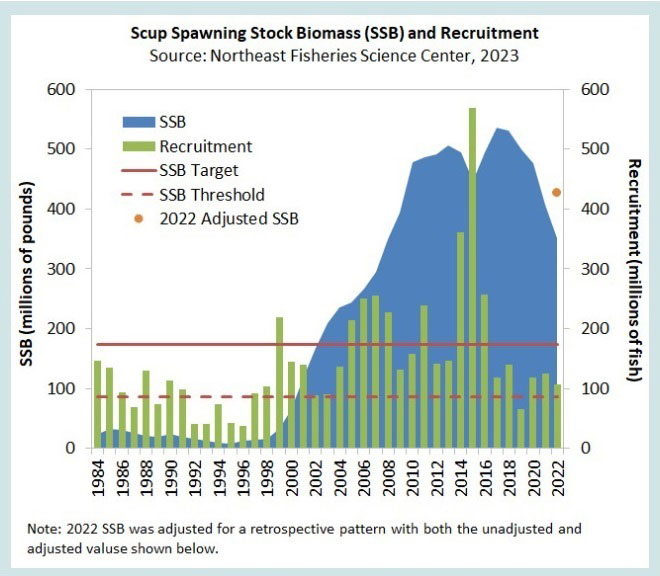
While it’s hard for many folks to wrap their head around the new harvest control rule when it comes to losing fluke quota, the new management mechanism does give us a break for black sea bass and porgy. The problem is, that “break” still comes by way of a sharp stick in the eye.
According to the ASMFC – the commission tasked with management inside state coastal waters out to 3 miles – the last peer-reviewed stock assessment on black sea bass in 2021 found the spawning stock biomass (SSB) for sea bass estimated at 65.63 million pounds, more than two times the actual target of 31.84 million pounds. Similarly, ASMFC accepts that a 2023 stock assessment on porgy found SSB in that fishery to be at 426 million pounds or more than twice the target of 173 million pounds.
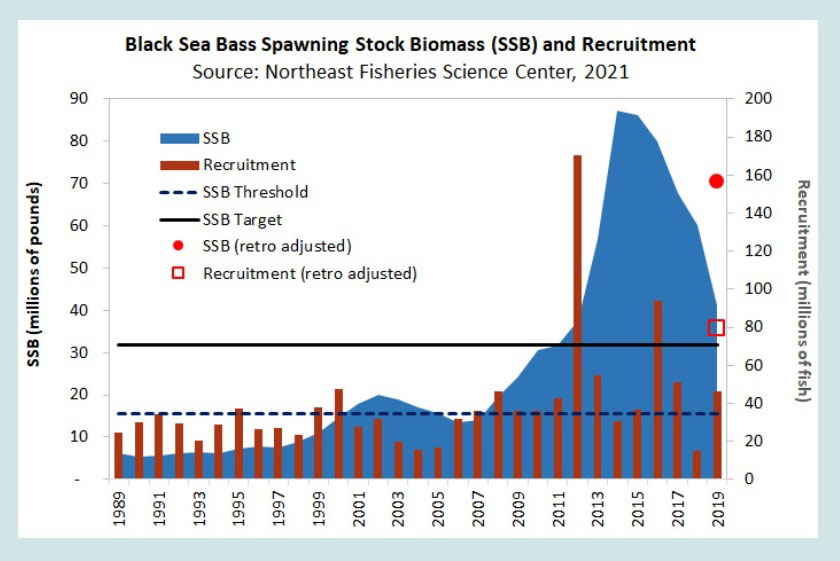
With sea bass and porgies both healthy and two times larger than the target biomass, one might reasonably assume that recreational fishermen would be seeing an increase in quotas at some point. However, ASMFC/MAFMC originally divulged that we’d be seeing a 25% cutback in both fisheries based on the old way of recreational management. The new process under the harvest control rule will help smooth over the cuts, to the point that black sea bass should remain status quo for ’24, while the porgy quota needs to be cut back by 10% this season.
It’s not just the anglers who are troubled by the cutbacks either. Mike Waine, ASA’s Atlantic Fisheries Director since 2018, says anglers are blowing through our RHL for porgies and sea bass according to the MRIP numbers, a sign perhaps that those fish stocks are healthy. “The stock is increasing, yet we’re decreasing our harvest levels, it doesn’t make sense,” Waine said.
On The Striper Front
The striper world was turned on its head in May of 2023 when the ASMFC and its Atlantic Striped Bass Management Board (Board) took emergency action in voting to modify recreational striped bass regulations, adopting a one fish bag and a 28- to 31-inch size limit. “This action responds to the unprecedented magnitude of 2022 recreational harvest, which is nearly double that of 2021, and new stock rebuilding projections, which estimate the probability of the spawning stock rebuilding to its biomass target by 2029 drops from 97% under the lower 2021 fishing mortality rate to less than 15% if the higher 2022 fishing mortality rate continues each year,” said ASMFC’s Tina Berger. This emergency ruling was ultimately carried over into the 2024 season in August when the Board convened again in Arlington, VA.
While many folks had hoped to see a change in striped bass regulations for 2024, a series of public hearings along the Striped Coast back in late fall took the wind out of many sails as ASFMC moved forward something called Draft Addendum II to Amendment 7 to the Interstate Fishery Management Plan (FMP) for Atlantic Striped Bass. The addendum is pretty much an adjustment to the striped bass FMP designed to support rebuilding of the striped bass stock by reducing fishing mortality in both the commercial and recreational sectors.
As Berger previously alluded, the 2022 recreational effort and harvest data from MRIP (see NOAA’S “BOMBSHELL” above) indicates to fisheries managers that we will not be able meet the 2029 striped bass rebuilding target unless overall mortality in the striped bass fishery is reduced. According to the ASMFC, statistical projections indicate that a 14.5% reduction in total removals relative to 2022 is needed to have a 50% chance of being at or below the fishing mortality target in 2024. For the recreational fishery, the Draft Addendum proposes recreational bag and size limit options for the ocean and Chesapeake Bay regions, including options with different limits on for-hire trips.
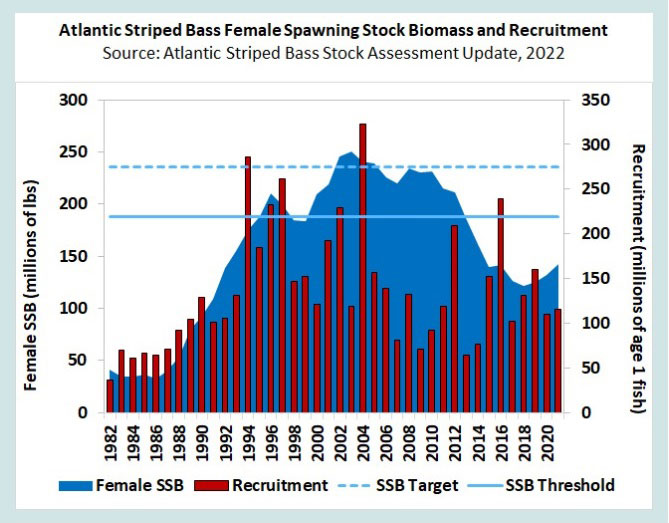
The state of New Jersey hosted a second ‘in-person’ public hearing on December 5 to review the various options and gather public comment. Approximately 50 people attended the meeting in Manahawkin with several folks providing comments while expressing their displeasure with the ASMFC process and preference for ocean recreational options for striped.
I recorded a bunch of statements that I’ll probably refer to in the future, but to summarize the tenor of the meeting, some folks wanted the state of New Jersey to fight the ASMFC proposal by voting in favor of Option A (status quo), and a couple of for-hire captains liked Option C which would have private anglers fishing on the same 28- to 31-inch slot while for-hire passengers would have a 28- to 33-inch. However, the majority of New Jersey attendees in December spoke in favor of Option B which would carry over the same regulations again (one striper from 28 to 31 inches) for all anglers, private and for-hire.
What I found quite apparent from the December 5th hearing was that everyone who stepped to the microphone to speak about New Jersey’s Striped Bass Bonus (SBBP) program spoke in favor of the bonus, some pleading with the state officials to ensure that the bonus program was kept in place. Striped bass of course has no-sale gamefish status in New Jersey, and the state offers anglers the ability to apply for an SBBP tag to harvest a 24- to less than 28-inch striped bass from the unused commercial quota. In 2002, anglers harvested 36,807 pounds from a 215,912-pound commercial quota; should the commercial sector also take a 14.5% quota reduction in 2024, a hypothetical reduction in SBBP landings would come in around 31,470 pounds of striped bass.
The final public comment period for Draft Addendum II ends on December 22, with the ASMFC and its Board expected to review public comment, select management measures and consider its final approval during the commission’s winter meeting from January 23-25. All stock assessment images for this story can be found – with further details on upcoming meetings and regulatory actions – at ASMFC.org.



